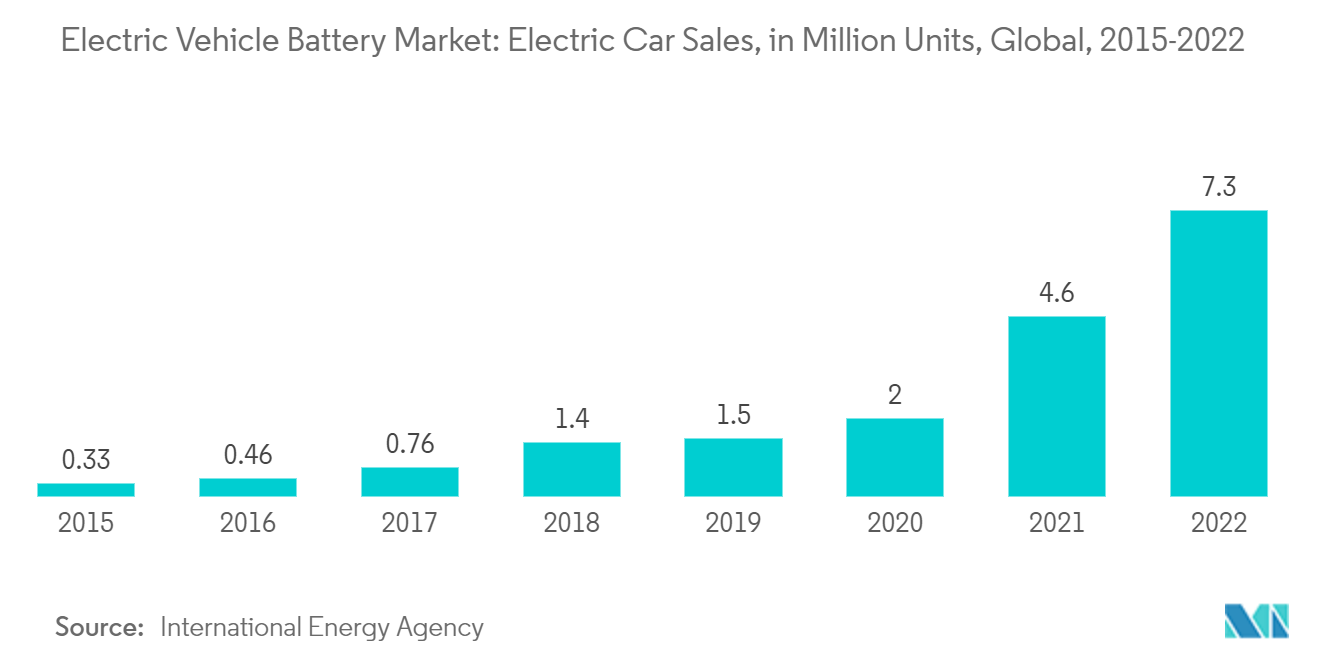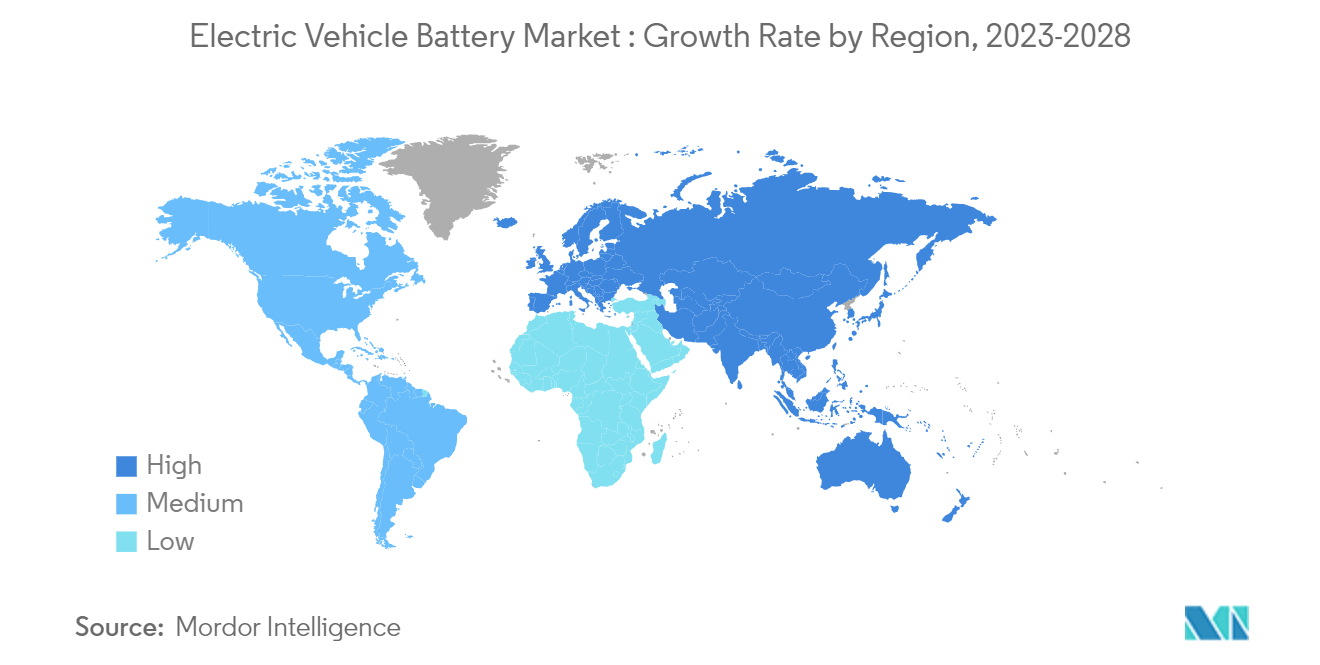Market Trends of Electric Vehicle Battery Industry
Lithium-ion Battery to Dominate the Market
- A lithium-ion battery is a type of rechargeable battery installed in electric vehicles and has a higher energy density when compared to nickel-cadmium and lead-acid rechargeable batteries. These features of the lithium-ion batteries will enable the manufacturers to save space by reducing the overall battery pack size. It is one of the lightest metals. Although lithium-ion batteries do not contain any lithium metal, they contain ions.
- Lithium-ion battery is gaining more popularity compared to other battery types, majorly due to its favorable capacity-to-weight ratio. Other factors that contribute towards boosting its adoption include better performance (long life and low maintenance), better shelf life, Environment friendly and fast charging. The price of lithium-ion batteries is usually higher than other batteries but it has started declining due to increase in R&D activities by other competitors.
- Lithium-ion batteries have traditionally been used mainly in consumer electronic devices, such as mobile phones and PCs, but are increasingly being redesigned for use as the power source of choice in hybrid and the complete electric vehicle (EV) range, owing to factors, such as low environmental impact, as EV does not emit any CO2, nitrogen oxides, or any other greenhouse gases.
- SVOLT energy Technology plans to build the first European lithium-ion cell factory in Saarlouis, Germany, with production scheduled to begin by the end of 2023.
- In May 2022, Stellantis N.V. and Samsung SDI announced the construction of an electric-vehicle lithium-ion battery manufacturing facility in Kokomo, Indiana, United States. It is anticipated that the plant will be operational in 2025, with an initial capacity of 23 GWh, with an aim to increase to 33 GWh in the next few years. The joint venture company is going to invest over USD 2.5 billion in the manufacturing plant.
- Lithium-ion batteries are more than safer than other battery technologies, and all the battery manufacturers ensure safety measures and standards to protect consumers in case of a battery failure.
- The emergence of new and exciting markets via electric vehicles for both personal and commercial vehicle applications is projected to drive the demand for lithium-ion batteries across the globe. Furthermore, lithium-ion batteries have several merits over other batteries (i.e., valve-regulated lead-acid), which make it preferable to be used in data centers.
- Further, the share of EVs in total passenger cars has been increasing and owing to the increased sales, the demand for lithium-ion batteries in Europe and North America has been increasing. Moreover, with the 'Green Deal policy' launched in 2019 by the European Union, the share of EVs is likely to increase, further driving the demand for lithium-ion batteries during the forecast timeframe. 'Green Deal Policy' aims to reduce the carbon emission by more than 50% by 2030 to achieve carbon neutrality target by 2050.
- The sales of electric vehicles is increasing significantly across the world. The global sales reached 7.3 million units in 2022 increased from 4.6 million in 2021. The rising sales of electric vehicles leads to rise in the demand for lithium-ion batteries.
- Hence, owing to the above points, the lithium-ion batteries are expected to dominate the market during the forecast period.

Asia-Pacific Expected to Witness Significant Growth
- The Asia-Pacific region is expected to dominate the global market. With the increasing deployment of electric vehicles in countries such as China, Japan, and India, and the high demand for vehicles with urbanization and increasing power purchase parity, the usage of lithium-ion batteries is expected to witness significant growth in the region.
- Favorable policies, such as the energy efficiency standards and increasing peak demand charges and technological advances, have led to the commercial and industrial (C&I) sector receiving more attention from project developers, primarily driven by strong growth in China and India, which, in turn, is expected to drive the demand for lithium-ion-based energy storage systems in the region.
- China is one of the largest markets for electric vehicles, and the increasing adoption of electric vehicles in the country has been in line with the clean energy policy. Moreover, the Government of China has been providing both financial and non-financial incentives to promote the adoption of electric vehicles.
- In India, lithium-ion batteries are mainly used in electric vehicles. India is a major importer of lithium-ion batteries in the Asia-Pacific region and during April-November 2022, the country had imported approximately 548.6 million units of lithium-ion batteries and the country imported around 616.8 million units of lithium-ion batteries during 2021-2022 worth USD 1.83 billion.
- The government of India is targeting the conversion of two and three-wheelers into 100% electric ones and the total automotive sales to 30% into e-mobility by 2030. Currently, India is dependent on other countries for sourcing EV batteries, which has resulted in the hiked price of EVs. The penetration of EVs in the Indian automotive sector is expected to bolster indigenous manufacturing of Li-ion batteries to make them economically viable.
- Hence, owing to the above points, Asia-Pacific is expected to witness a significant growth in EV battery market during the forecast period.

